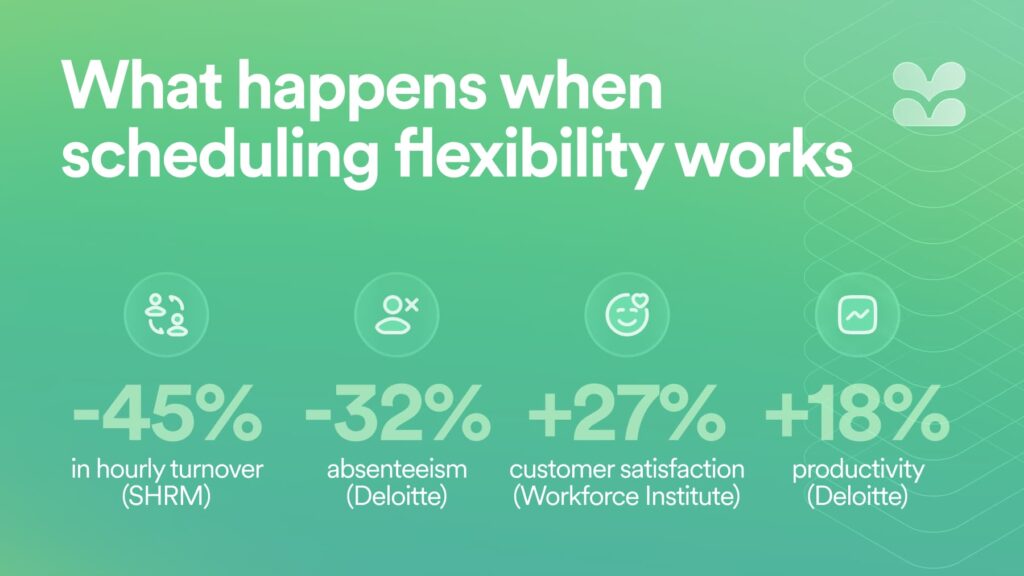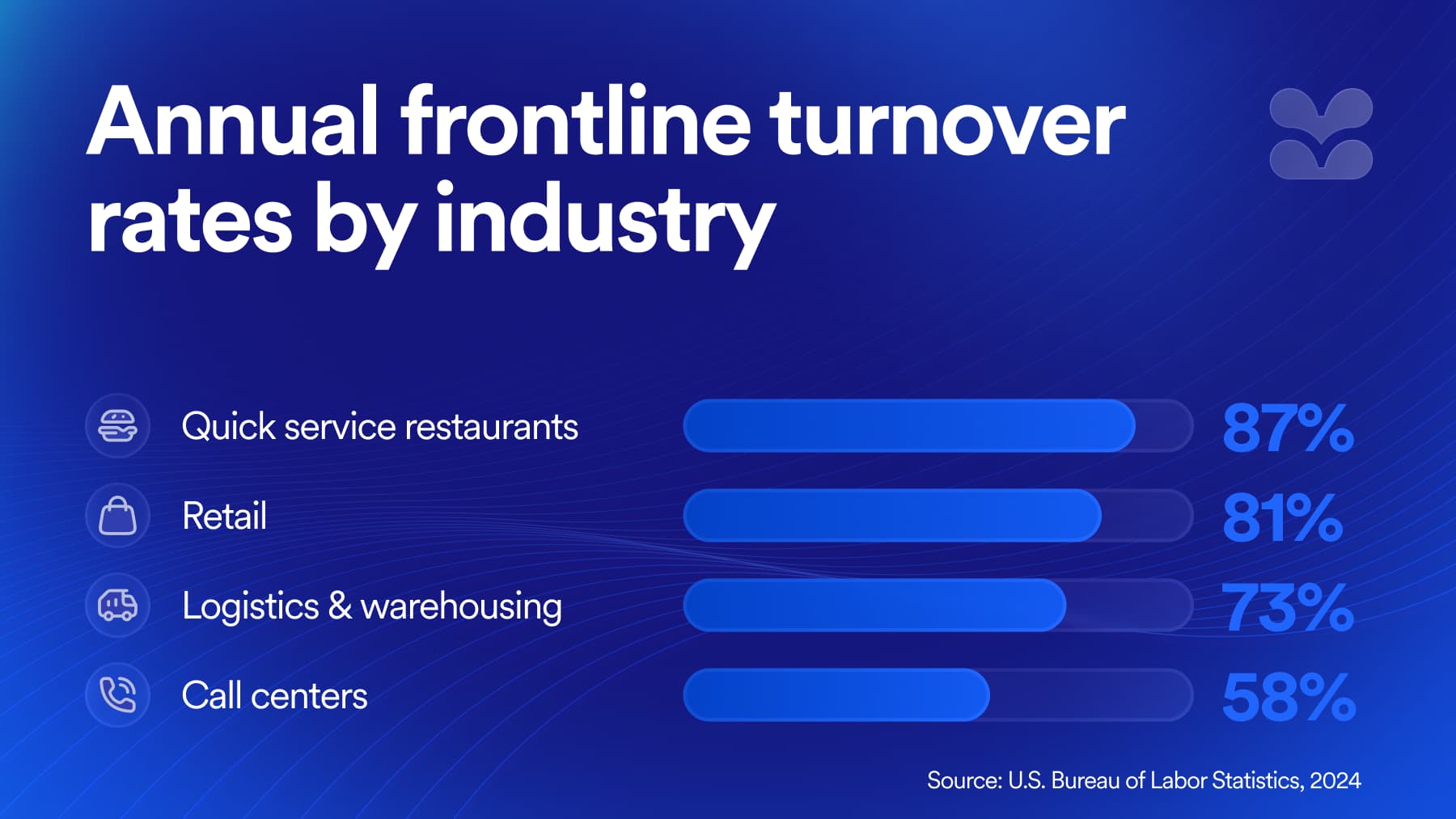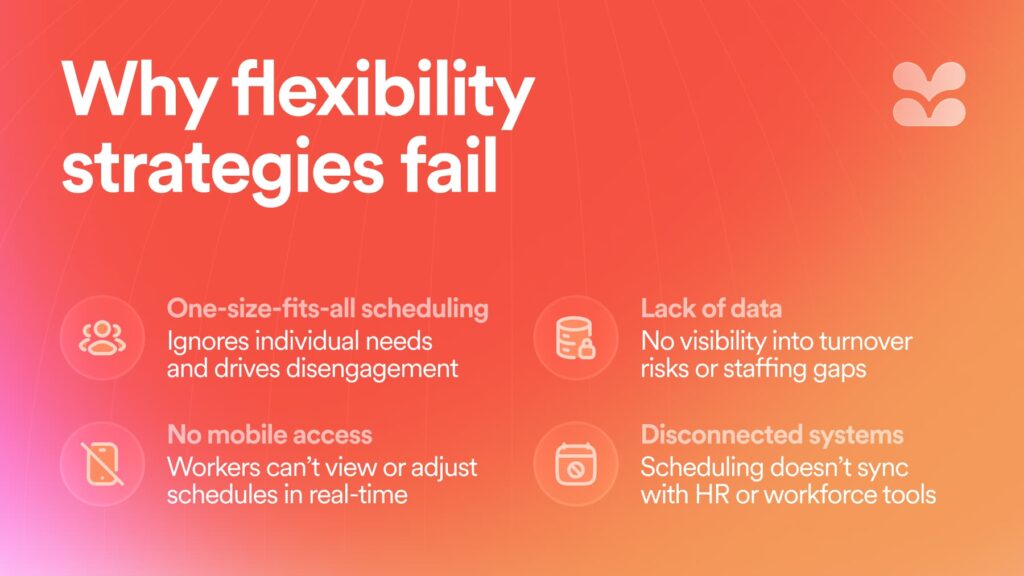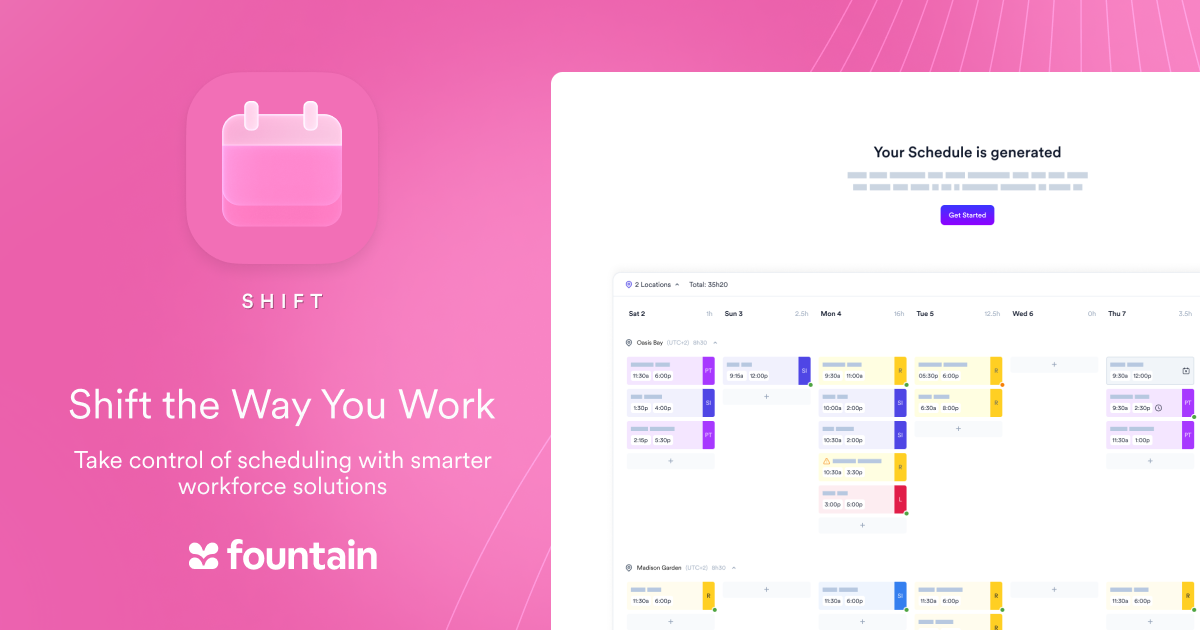The Frontline Worker Retention Crisis in 2025
Companies are losing frontline staff faster than they can replace them, creating financial strain and operational disruptions. As turnover rates climb, scheduling flexibility has emerged as a critical factor in frontline worker retention. Organizations ignoring this essential element face higher quit rates, increased recruitment costs, and declining performance.
According to data from the U.S. Bureau of Labor Statistics, high-volume hiring industries experience significant annual employee turnover. The rates are 87% in quick service restaurants, 81% in retail, 73% in logistics and warehousing, and 58% in call centers.
To stay ahead, employers must evolve their workforce strategies to meet the expectations of today’s frontline workers. Effective scheduling flexibility isn’t optional—it is essential for hiring and retaining frontline workers.
Why Schedule Control Matters More Than Pay for Frontline Workers
76% of hourly workers rank flexible scheduling as equal to or more important than pay when evaluating a job. Yet most companies rigidly schedule frontline roles and give little consideration to employee preferences, caregiving responsibilities, or personal needs. For workers, this lack of control erodes job satisfaction. For employers, it results in churn, increased absences, and lost productivity.
Many HR leaders have responded to this trend with surface-level fixes, only to find those programs fall short. Without visibility, openness to change, and the right technology to support flexibility at scale, retention gains remain unseen.
In this post, we’ll explore:
- Why flexible scheduling is the single most effective lever for improving frontline retention
- The real cost of getting it wrong
- Where traditional workforce strategies fall short—and how to avoid common pitfalls
- What leading employers are doing to implement high-impact, flexible scheduling programs
Frontline workers want more control. Employers who deliver it—intentionally, and at scale—are seeing higher engagement, better performance, and stronger retention.

Flexible scheduling drives measurable gains in retention, productivity, and customer satisfaction.
Why Frontline Worker Retention Is Plummeting
Frontline workers are quitting faster than companies can replace them. A lack of workforce flexibility is a primary driver of turnover. Traditional top-down scheduling no longer works for today’s hourly workforce.
Gen Z and Millennial Frontline Workers: Meeting Their Scheduling Needs
Schedule flexibility is a key consideration for most frontline workers. For 76% of them, it’s a key reason to stay at a job, often more than pay. This is even more true for younger generations, who are the largest group in frontline jobs. 83% of Gen Z and Millennial hourly team members identify flexibility as a key consideration when choosing a job.
Scheduling flexibility is the #1 way to reduce turnover among frontline employees—even more than compensation. If employees have flexible schedules, they are more likely to stay. In fact, employees without flexibility show 29% lower engagement and are much more likely to report burnout.
High Turnover in Frontline Industries Signals an Urgent Need for Flexible Scheduling Solutions
Companies that continue to rely on inflexible scheduling systems face rising quit rates, unplanned absences, and inflated recruitment costs. The data speaks for itself. According to the Bureau of Labor Statistics, turnover rates remain critically high in frontline-heavy industries:
- Quick service restaurants: 87% annual turnover
- Retail: 81% annual turnover
- Logistics and warehousing: 73% annual turnover
- Call centers: 58% annual turnover
These statistics represent widespread problems across industries that rely on large, dispersed workforces. Unless companies take thoughtful steps to support today’s workers, they will struggle to retain these key employees.

Turnover rates remain highest in frontline-heavy industries, with QSRs and retail facing the steepest challenges.
Common Flexibility Program Mistakes That Increase Frontline Turnover
While many organizations recognize the importance of flexibility in improving frontline worker retention, not all flexibility initiatives yield positive results.
Weak or poorly planned flexibility programs can cause more turnover and lower employee satisfaction. To avoid these negative outcomes, HR leaders must understand and avoid these common mistakes when designing flexibility strategies.
One-Size-Fits-All Scheduling Systems
Implementing uniform scheduling policies that fail to take into account individual employees’ needs can backfire. Instead, offering more flexible scheduling options tailored to employee preferences is a key strategy in supporting the frontline workforce.
Lack of Mobile-Optimized Tools
In today’s digital age, frontline workers expect seamless access to their schedules via mobile devices. Despite increased access to real-time communication tools, there is a growing demand for more asynchronous alternatives. Companies need to consider mobile-friendly scheduling tools to meet their workers’ expectations.
Insufficient Data Analytics
Without robust analytics, it’s challenging to identify patterns that contribute to turnover. Studies show that understanding the drivers of employee engagement is essential for improving workplace satisfaction, company culture, and retention.
Disconnect Between Scheduling Systems and Workforce Management Tools
Disconnected scheduling and workforce systems can lead to problems, especially when employees can’t easily access them on their phones. Despite this, many employers haven’t effectively adopted flexible work practices with strong mobile support. This underscores the need for integrated solutions that are also mobile-friendly.
By addressing these common pitfalls and implementing well-designed flexibility programs, organizations can improve employee satisfaction and reduce turnover.

Without the right tools, even well-intended flexibility initiatives fall short.
The Real Cost of Frontline Employee Turnover in 2025
Turnover isn’t just a people problem—it’s a business risk with significant financial consequences. It costs an average of $4,700 to replace a single hourly worker. This includes expenses tied to recruiting, interviewing, onboarding, training, and loss of productivity.
It usually takes new frontline employees 4 to 6 weeks to become fully productive. While new hires get up to speed, the added pressure might stress existing teams, negatively impact customer service, and cause work to back up. High turnover hurts companies: they run 22% worse, and customer happiness drops 38%.
The ripple effects can be particularly devastating in high-volume industries. For example:
- Consider a logistics company with 500 hourly employees. If half of these employees leave each year, the company could lose over $2 million because of turnover. A high rate of employee departures results in significant costs.
- Now, imagine a fast-food chain where many staff members leave every month. This situation can lead to lower sales, inconsistent customer service, and managers becoming overloaded, potentially affecting operations at other locations as well.
Conversely, companies actively providing flexible work options are reducing their hourly turnover rates by up to 45%. This not only generates cost savings but also yields measurable improvements in productivity, employee morale, and brand perception.
Losing employees is a major business problem that needs a well-thought-out solution. For frontline jobs, that solution starts with flexible scheduling.
Conclusion: The Strategic Advantage of Frontline Scheduling Flexibility
Clearly, frontline flexibility is no longer a perk; it is a fundamental necessity. Scheduling flexibility now actively shapes employee engagement, retention, and efficiency. Workers today expect more from their jobs, especially younger people who work by the hour. As things change, the difference between flexible companies and inflexible ones will continue growing.
HR leaders who make flexibility a key part of their employee management are already seeing positive changes. With flexibility, companies see less turnover, attract more talent, run more efficiently, and have happier customers. This also leads to cost savings and greater loyalty from both employees and customers.
As we look ahead, the message is simple: frontline workers want control. And companies that give it to them—with the right systems, tools, and mindset—will win the talent war.

